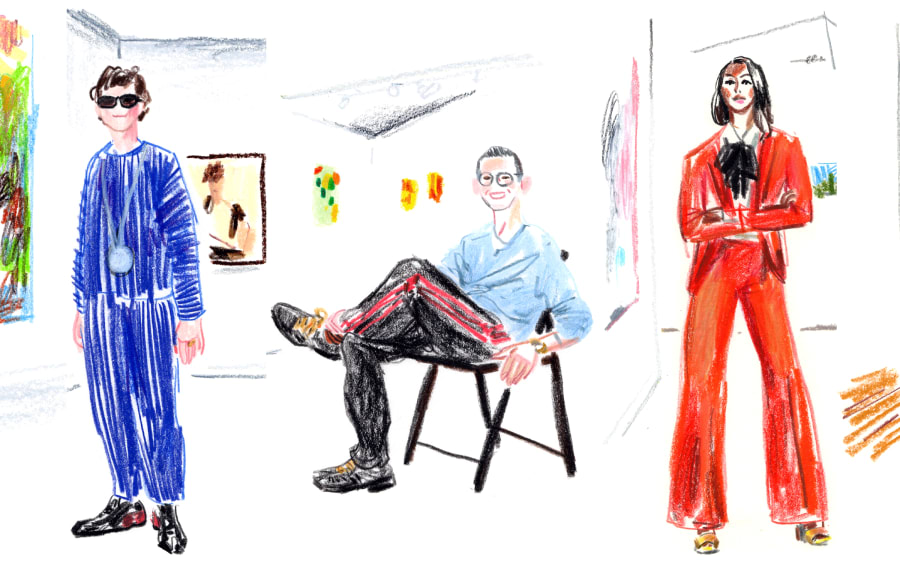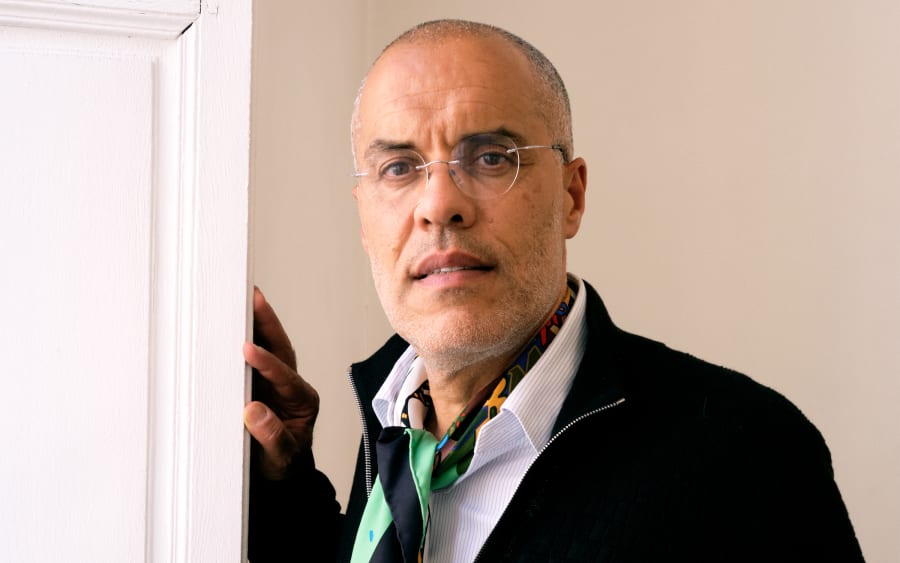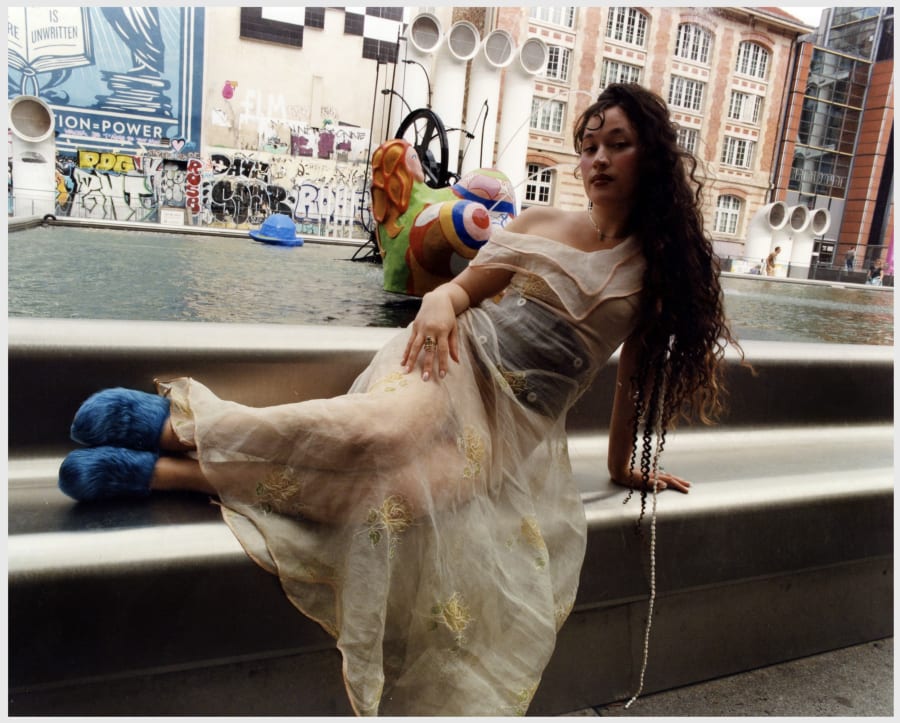‘It’s easy to find me: if there’s an opening at one of the galleries, I’m there,’ laughs Mariane Ibrahim. The gallery that bears her name operates on three continents and represents around 20 artists, including Raphaël Barontini, Amoako Boafo, Patrick Eugène, Clotilde Jimenez, Zohra Opoku, and Peter Uka. From Chicago to Paris by way of Mexico City, her exhibitions celebrate multiple variations of a dreamlike, spiritual, and mutant figurative painting of African descent. We meet at her Paris gallery on Avenue Matignon, which since September 2021 has occupied two floors of a refined Haussmann building. ‘I wanted to showcase these young artists in an unexpected neighborhood,’ she says. At the opening, many still saw her as the French girl from Chicago. ‘A friend told me that to be recognized in France, you often have to leave and then come back,’ she recalls. So that is what she did.
Taking advantage of the hope for change of the Obama years, Ibrahim headed for the United States. Her first stop was Seattle, where in 2012 she opened her first gallery, M.I.A. The acronym was chosen for her maiden name, Mariane Ibrahim Abdi, but also stood for ‘Missing in Art.’ ‘Starting a program of Afro-centricity in Seattle was complicated because there’s no real connection,’ she says. Yet she went for it: ‘I had to do this project anyway, because sooner or later, Afro-descendant artists were going to emerge and occupy the art scene. I’ve always known that.’ Twelve years on, she is almost surprised by her success: ‘It was intense. I had no local support, nothing. I’d never worked in an art gallery; nobody had taught me how to put a painting on a wall.’
Ibrahim was born in Nouméa, New Caledonia, to Somali parents. She owes her first aesthetic emotions to Egyptian art: ‘My family comes from a region linked to ancient Egyptian history, and my childhood was filled with tales of Hatshepsut and the warrior queens.’ She grew up between France and Somalia in a family of orators and poets. In her teens, she took up photography and portraiture, a practice that enabled her to come to terms with her plural identity: ‘You quickly feel like a chameleon, and it took me a while to understand that you shouldn’t choose one [identity] but accept them all. It’s a concept I found in Lorraine O’Grady’s ‘both/and’ – a great artist with whom we’ve just started working.’
Her career path took her to London to study communications and the media, with a view to working for a TV channel. ‘What interested me most was cultural programming and the idea of opening a window on the world,’ she says. ‘In the end, I didn’t stray too far from this desire. Through the gallery, I see and invite people to discover the world in a different way.’
In 2019, she left Seattle for Chicago, a city where she immediately felt adopted. She opened her gallery in a former warehouse with a solo show by photographer Ayana V. Jackson. ‘I always look at what concept is going to allow me to open a space, because that indicates what tone you’re going to give,’ she explains. ‘I couldn’t go to Chicago without an African American woman, because I feel that the whole of American capitalist society has been built on the backs of Black women.’ In Paris, Ibrahim also wanted to return with an African American figure, a ‘ghostly spirit’ who would enable her to build bridges: ‘This guardian figure was Josephine Baker. I built an exhibition around her, with all the artists in the gallery, entitled ‘J'ai deux amours’ (‘I have two loves’) after one of Baker’s most famous songs.
A few months later, Josephine Baker entered the Panthéon. ‘We must have been lucky,’ laughs the gallery owner. By the early 2020s, the gallery had become an essential part of the Paris scene: ‘The rise was quite rapid, because the world itself is moving much faster. Back in the day, we used to send each other faxes!’ This frenetic pace prompted Ibrahim to take a break from fairs last year. She took advantage of this fallow year to prepare for the arrival of a third gallery. She also observed, exchanged, and planted the seeds of future projects. Above all, she spent as much time as possible on site: ‘Collectors are happy to see gallerists in their space. I think that’s the trend; that we need to get back to something more human.’
In February 2023, the gallery took up residence in Mexico City, an ancient yet contemporary city whose Afro-Mexican history remains little-known. The airy space, with its 1,000 m2 of floor space and seven exhibition rooms, opened with an exhibition by Clotilde Jiménez, an American artist of Puerto Rico descent now based in the city. ‘The approach is both educational and artistically freer,’ explains Ibrahim of this new chapter, which places particular emphasis on thematic exhibitions and monumental interventions. In September, the Mexican gallery opened an exhibition curated by Marisol Rodríguez, newly appointed as curatorial director of the gallery’s three locations. She invited six young painters from the Paris scene: Djabril Boukhenaïssi, Marcella Barceló, Camille Fischer, Alexandre Lenoir, Johanna Mirabel, and Marie de Villepin. ‘The aim is really to create conversations; to generate cross-fertilization,’ enthuses Ibrahim. ‘I’ll always be dedicated to Afro-descendance, but it’s also international. It has given me the strength and flexibility to work with artists from all over the world. Now more than ever, I’m convinced that the world is becoming a little more global every day.’
Mariane Ibrahim will participate in the Galeries sector of Art Basel Paris 2024. Learn more here.
Carmen Neely
‘Chronic Conditions’
Mariane Ibrahim, Paris
From October 11 to November 30, 2024
Ingrid Luquet-Gad is an art critic and PhD candidate based in Paris. She teaches art philosophy at Université Paris 1 Panthéon-Sorbonne.
Caption for header image: Mariane Ibrahim in her gallery avenue Matignon, Paris, 2024. Photograph by Inès Manai for Art Basel.
Published on October 2nd, 2024.


